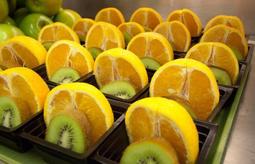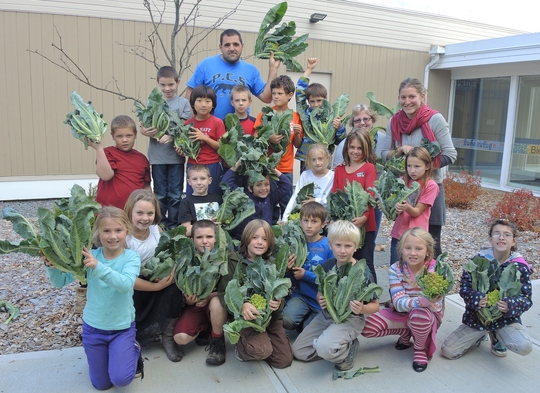 Gitta Grether-Sweeney: Senior Director of Nutrition Services at Portland Public Schools
National School Breakfast Week is March 6 - 10
The School Nutrition Association (SNA) is celebrating National School Breakfast Week and wants us to "Take the School Breakfast Challenge". This challenge encourages students, parents, and teachers to start their day with a healthy breakfast. Research indicates that students who participate in school breakfast show improved attendance, behavior, standardized achievement test scores, as well as decreased tardiness (Food Research & Action Council). Breakfast is the perfect meal to add local foods such as fruit and dairy. Promote school breakfast in your school by downloading these marketing materials. Don't forget to share in celebration by sending your stories and photos to SNA, you might just end up in the School Nutrition Magazine!


The American Egg Board (AEB) is inspiring us to think differently about eggs. Their role is to increase the demand for eggs and egg products through research, education, and promotion. Check out these six facts you probably didn't know about eggs:
- One large egg has 6 grams of high-quality protein and is nutrient rich. Kick-starting the day with protein for breakfast gives children the mental and physical energy they need to focus and learn.
- Eggs are a lower-cost meat alternative – allowing schools to devote more tray cost to fresh produce and other items.
- Eggs make great vegetarian and gluten-free meal options that appeal to students.
-
Hard-boiled eggs without added fat can now be sold as a Smart Snack in schools, providing a perfect snacking opportunity. Merchandise this new offering in portable packaging and pair with veggies.
- Eggs are versatile. They can be the star or play a supporting role in breakfast, lunch, snack, and supper programs.
- Eggs are always on trend. From Latin America to Asia and ports in between, eggs are a natural fit in any cuisine, from ramen noodle bars to stir-fries and tacos. Eggs are a great protein addition to grab n’ go salads and snack boxes too. For more ideas, check out these recipes from the American Egg Board.
Check out these resources from the American Egg Board:
How-To Videos - A five-video series on how to use eggs in school nutrition programs has just been released by the American Egg Board. These
videos are instructional, inspirational, and can serve as egg-cellent
training tools for your staff.
Tools for Schools - Using
eggs in schools just got easier with a new webpage full of downloadable
resources. Download posters, logos, labels, and use to promote eggs
to your students.
Shell Egg Safety and Handling - Are
you sourcing shell eggs locally, or considering it? We’ve got tips on shell egg
handling best practices and safety requirements.

 |
|
FRAC School Breakfast Scorecard
The Food Research & Action Center (FRAC) just released their annual School Breakfast Scorecard for the 2015-2016 school year. West Virginia was ranked number one as having the highest ratio of low-income students participate in the school breakfast program. For every 100 students who participated in the school lunch program, West Virginia had 83.9 students participate in the school breakfast program. The gap between the number of students who participate in school breakfast and school lunch continues to narrow, indicating that more students are getting a healthy start to their day. Read the FRAC School Breakfast Scorecard and listen to Breakfast Matters: Sourcing and Storing Local Fresh Foods for School Breakfast webinar for more information.
|
|
In June 2015, the Nevada Department of Agriculture signed into law the, "Breakfast After the Bell" bill which mandated that schools with over 70 percent of students eligible for free/reduced lunch provide opportunities for students to access breakfast. In one school year, Nevada has doubled the number of students participating in school breakfast from 20 percent to 44 percent. Learn more about Nevada's School Breakfast Challenge.
|
|
 |


Putney Central School, located in
Putney, Vermont, has an active and evolving Farm to School Program. With a dedicated school board and enthusiastic teachers, they have a large campus that has ample
space for their community garden. Last year, students planted and harvested over 200
pounds of potatoes and several bushels of brussels sprouts, all of which were
promptly utilized by their school food program. Plans for the spring include
construction of a hoophouse and the addition of a few fruit trees and blueberry
bushes to their burgeoning orchard. They are thrilled with the
progress of the multi-faceted Farm to School Program and have already seen
major improvements in food quality and student participation. They switched to "After the Bell Breakfast" and increased school breakfast participation by almost 400%! The monthly taste tests have been a big success and students seem
genuinely enthused about participating in planning and working in the garden.
A large walk-in refrigerator/freezer will be installed this spring, which combined
with a new hoophouse, will allow them to dramatically increase local food
production and storage.
| 








